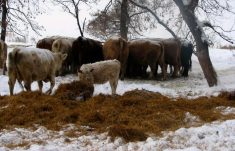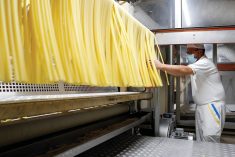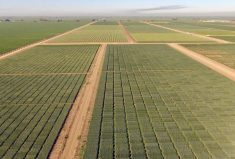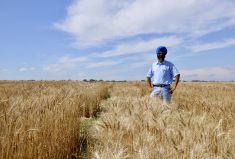Some farmers are getting more in the bin than they expected this harvest — a bit of a silver lining in a tough year that has swung from drought to too rainy in many areas.
“People are seeing a little better yield than they originally expected, maybe five bushels more,” said Kelly McIntyre, who grows canola and wheat southwest of Fairview.
“It’s still not great because it’s still a drought.”
Most producers he’s talked to have higher yields than expected.
“It just seems to me, looking at the plants themselves, I think the crop was stunted in height,” said McIntyre. “And whatever energy it had, it put into pod size. It made an effort to produce as much seed as it could after it kind of got shortened.
Read Also

New crop insurer policy enables easier startup for faba beans
Agriculture Financial Services Corporation updated its normals for faba beans, which may open the door for more Canadian producers to feel comfortable growing the pulse crop in the future.
“I think that’s what happened, in my unprofessional opinion.”
But 20 to 25 bushels for canola and 30 to 35 bushels for wheat being seen in his area still doesn’t cut it.
“They’re happy that they’re getting way more than they thought, but they’re not happy because it’s way below the cost of production,” he said. “There’s lots of talk about crop insurance.”
McIntyre has been pleased with his own crops during a drought year, and thinks that his zero-till practices could have contributed to his yields. He got his wheat before the first round of rain and saw good grades, but a frost at the start of September will have hurt later-harvested crops.
The Peace region hasn’t recovered from drought, but some places have had three to eight inches of rain since the beginning of August.
Eight hundred kilometres to the southeast it’s been so wet that Steve Marshman can’t “even hazard a guess as to where guys are at” in their harvest.
It’s been a hard, strange year for the owner of Rocking Horse Land and Cattle Incorporated near Rosebud. No rain until the end of July, then a whopping 15 inches and a large amount of hail, which took out some crops. Not being able to get the spraying done before the rains came means lots of weeds and a tricky harvest.
But it’s also a year when no till has shined, he said.
“Even on land that I heavy harrowed versus land that was untouched, when I went in with the no till, there was a huge difference on germination,” he said.
His crops are also shorter than normal, and the heads on the crop are a bit bigger than normal because it rained while they were filling.
“We’ve swathed the canola, but we haven’t taken any in yet. It could be good. We don’t know until we start combining,” Marshman said in a mid-September interview.
While yields will be lower than the five-year average, many producers are like McIntyre and seeing better-than-expected results, said Mark Cutts, crop specialist with Alberta Agriculture’s Ag Info centre in Stettler
“They may not be down quite as low as people were thinking, based on the type of summer that we had,” he said.
An early-September provincial forecast put yields at 80 per cent of the five-year average, but the range is about 77 to 85 per cent of average, he said.
“It comes down to when the rains came, and how much came,” said Cutts.
The northwest and northeast areas fared the worst.
“If you look at precipitation accumulation up until the first week of September, northwest and northeast of Edmonton certainly remains dry, compared to central Alberta which has picked up moisture in the last couple of months,” he said.
But Cutts, too, says reduced tillage is a factor in the uptick in forecasted yields simply because conserved moisture allowed that many more plants to get established.
That and timely rains in some areas will likely see a larger-than-forecast crop, said Bruce Burnett, weather and crop specialist with CWB (soon to become G3).
But “we had some pretty low expectations because of the drought for most of the year,” he said.
And while it may not be as bad as feared, it will still be bad, he added.
“Overall yields are still down considerably from last year.”
















